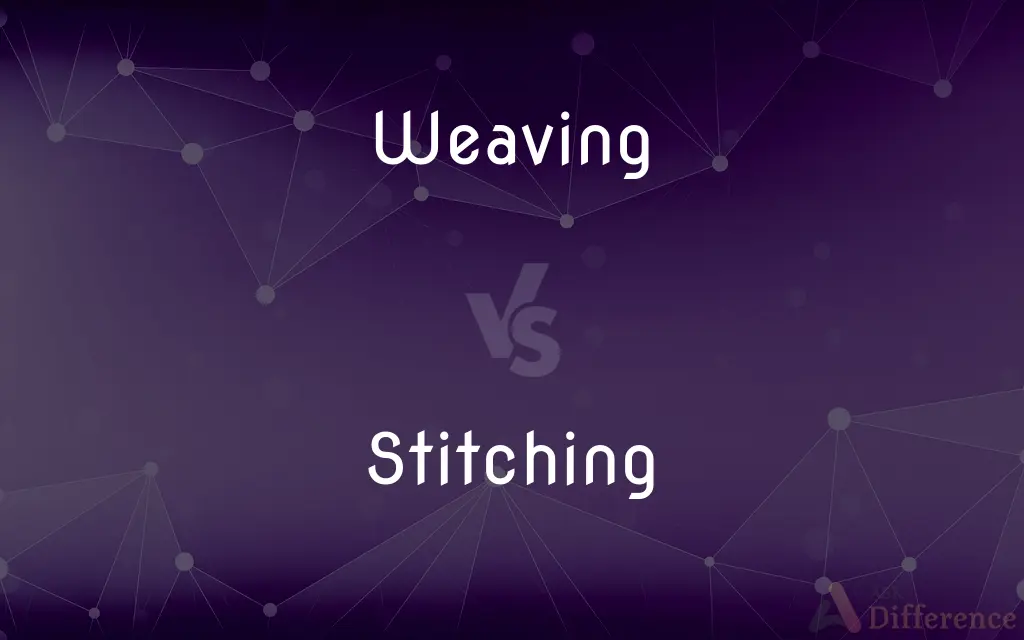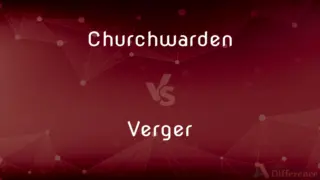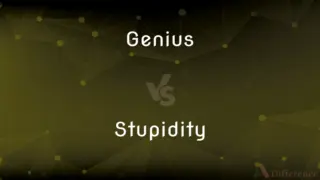Weaving vs. Stitching — What's the Difference?
By Maham Liaqat & Fiza Rafique — Updated on March 21, 2024
Weaving involves interlacing threads to form fabric, while stitching is sewing threads through material to join pieces or add designs.

Difference Between Weaving and Stitching
Table of Contents
ADVERTISEMENT
Key Differences
Weaving is the process of interlacing two sets of threads — warp (longitudinal) and weft (transverse) — at right angles to create a fabric. This technique is fundamental in fabric making, utilizing looms for the interlacement. Stitching, on the other hand, involves sewing threads through fabric or other materials using a needle to join pieces together, mend them, or create decorative patterns.
The primary purpose of weaving is to produce a new piece of fabric by integrating threads together. Stitching is mainly used for assembling pre-existing fabric pieces, repairing them, or adding decorative elements. Weaving creates the groundwork of a fabric, whereas stitching builds upon or alters existing fabric.
Weaving equipment ranges from simple hand looms to complex industrial weaving machines, emphasizing the creation of fabric from scratch. In contrast, stitching requires needles and thread, with the option of using hand sewing techniques or sewing machines for more complex or repetitive tasks.
The skills and techniques involved in weaving and stitching are distinct; weaving focuses on the setup and operation of looms and the interplay of warp and weft threads, while stitching emphasizes techniques like running stitch, backstitch, or embroidery, depending on the project's needs.
Comparison Chart
Definition
Interlacing warp and weft threads to create fabric.
Sewing threads through material to join, mend, or decorate.
ADVERTISEMENT
Primary Purpose
Producing new fabric from threads.
Assembling, repairing, or embellishing existing fabric.
Equipment
Looms (hand or industrial).
Needles and thread, sewing machines.
Techniques
Setup of looms, interlacing of threads.
Running stitch, backstitch, embroidery, etc.
Outcome
Fabric creation.
Joined or decorated fabric pieces.
Compare with Definitions
Weaving
The process of making fabric by interlacing threads.
Weaving on a traditional loom can produce intricate patterns.
Stitching
Can be decorative, such as in embroidery.
Embroidery stitches, like the French knot, add intricate details to fabric.
Weaving
Involves crossing warp and weft threads at right angles.
The tightness of the weave affects the fabric's texture and durability.
Stitching
The act of sewing fabric pieces together or adding designs.
Stitching the pieces carefully will ensure the garment's durability.
Weaving
Can be done by hand or on industrial machines.
Hand weaving offers unique, artisanal qualities, while industrial weaving ensures mass production.
Stitching
Can be done by hand or using sewing machines.
Sewing machines make repetitive stitching tasks quicker and more uniform.
Weaving
Fundamental in creating various types of textiles.
Weaving techniques vary globally, reflecting diverse cultural traditions in textile art.
Stitching
Involves various types of stitches for different purposes.
The backstitch provides strength to seams in clothing.
Weaving
Utilizes various types of looms and techniques.
Different weaving techniques, like plain weave or twill, result in distinct fabric structures.
Stitching
Essential for garment construction and repairs.
Mastering various stitching techniques is crucial for tailoring and alterations.
Weaving
Weaving is a method of textile production in which two distinct sets of yarns or threads are interlaced at right angles to form a fabric or cloth. Other methods are knitting, crocheting, felting, and braiding or plaiting.
Stitching
A single complete movement of a threaded needle in sewing or surgical suturing
Made multiple stitches.
Weaving
To make (cloth) by interlacing the threads of the weft and the warp on a loom.
Stitching
A single loop of thread or yarn made with an implement such as a sewing or knitting needle.
Weaving
To interlace (threads, for example) into cloth.
Stitching
A single loop or knot of thread used in closing a wound or incision in surgery; a suture.
Weaving
To construct by interlacing or interweaving strips or strands of material
Weave a basket.
Stitching
A way of arranging the threads in sewing, knitting, crocheting, or suturing
Used a purl stitch.
Weaving
To interweave or combine (elements) into a complex whole
Wove the incidents into a story.
Stitching
A sudden sharp pain, especially in the side.
Weaving
To contrive (something complex or elaborate) in this way
Weave a tale.
Stitching
(Informal) An article of clothing
Wore not a stitch.
Weaving
To introduce (another element) into a complex whole; work in
Wove folk tunes into the symphony.
Stitching
(Informal) The least part; a bit
Didn't do a stitch of work.
Weaving
To attach hair extensions to (hair).
Stitching
To fasten or join with stitches.
Weaving
To spin (a web, for example).
Stitching
To mend or repair with stitches
Stitched up the tear.
Weaving
Past tense & past participle often weaved To make (a path or way) by winding in and out or from side to side
Weaved our way through the heavy traffic.
Stitching
To decorate or ornament, as with stitches
"The sky was stitched with stars" (Mario Puzo).
Weaving
To engage in weaving; make cloth.
Stitching
To fasten together with staples or thread.
Weaving
To work at a loom.
Stitching
To make stitches; sew, knit, crochet, or suture.
Weaving
Past tense and past participle often weaved To move in and out or sway from side to side.
Stitching
Stitches, collectively.
The stitching is coming undone on this shirt.
Weaving
The pattern, method of weaving, or construction of a fabric
A twill weave.
A loose weave.
Stitching
Present participle of stitch
Weaving
A hairstyle in which hair extensions are attached to existing strands of hair.
Stitching
The act of one who stitches.
Weaving
(uncountable) The process of making woven material on a loom.
Stitching
Work done by sewing, esp. when a continuous line of stitches is shown on the surface; stitches, collectively.
Weaving
(countable) A piece of such material.
Stitching
Joining or attaching by stitches
Weaving
(countable) An unsteady motion back and forth.
Weaving
Present participle of weave
The motorcycle is weaving in and out of traffic
Weaving
Form of gerund
Weaving
The act of one who, or that which, weaves; the act or art of forming cloth in a loom by the union or intertexture of threads.
Weaving
An incessant motion of a horse's head, neck, and body, from side to side, fancied to resemble the motion of a hand weaver in throwing the shuttle.
Weaving
Creating fabric
Weaving
Walking unsteadily;
A stqaggering gait
Common Curiosities
Can weaving be done without a loom?
While traditional weaving is done on a loom, simple weaving projects can be done on hand-held frames or even with makeshift setups.
Are all fabrics made through weaving?
Not all fabrics are woven; some, like knitted or felted fabrics, are made through different processes.
What is the difference between a woven and a non-woven fabric?
Woven fabrics are made by interlacing threads, while non-woven fabrics are made by bonding or felting fibers together without interlacing.
Is stitching only used for fabric?
Stitching can be applied to various materials, including leather and paper, for functional or decorative purposes.
Is hand stitching still relevant with the advent of sewing machines?
Hand stitching remains relevant for detailed work, repairs, and in situations where the tactile quality and craftsmanship are valued.
Can stitching affect the durability of a fabric?
Proper stitching techniques can significantly enhance the durability and longevity of fabric products.
What role does weaving play in the fashion industry?
Weaving is crucial in the fashion industry for creating a wide variety of fabrics that are the foundation of garments and accessories.
Can stitching be considered a form of art?
Yes, techniques like embroidery elevate stitching to an art form, creating intricate designs and patterns.
How does the weave of a fabric affect its use?
The type of weave affects the fabric's strength, texture, and appearance, influencing its suitability for different applications.
Is knitting the same as weaving?
No, knitting involves creating loops of yarn to form fabric, which is different from the interlacing method used in weaving.
Is it possible to weave at home without professional equipment?
Yes, small-scale weaving projects can be undertaken at home using simple frames or DIY looms.
How has technology impacted weaving?
Technological advancements have led to more efficient and complex weaving machines, allowing for higher production rates and more intricate designs.
Can one create patterns with stitching?
Yes, stitching can create patterns, especially in embroidery, where various stitches are used to form designs.
How do different cultures influence weaving techniques?
Weaving techniques are deeply influenced by cultural traditions, with each culture having unique methods, patterns, and uses for woven textiles.
Is embroidery a type of stitching?
Yes, embroidery is a type of decorative stitching used to create patterns and designs on fabric.
Share Your Discovery

Previous Comparison
Churchwarden vs. Verger
Next Comparison
Genius vs. StupidityAuthor Spotlight
Written by
Maham LiaqatCo-written by
Fiza RafiqueFiza Rafique is a skilled content writer at AskDifference.com, where she meticulously refines and enhances written pieces. Drawing from her vast editorial expertise, Fiza ensures clarity, accuracy, and precision in every article. Passionate about language, she continually seeks to elevate the quality of content for readers worldwide.
















































